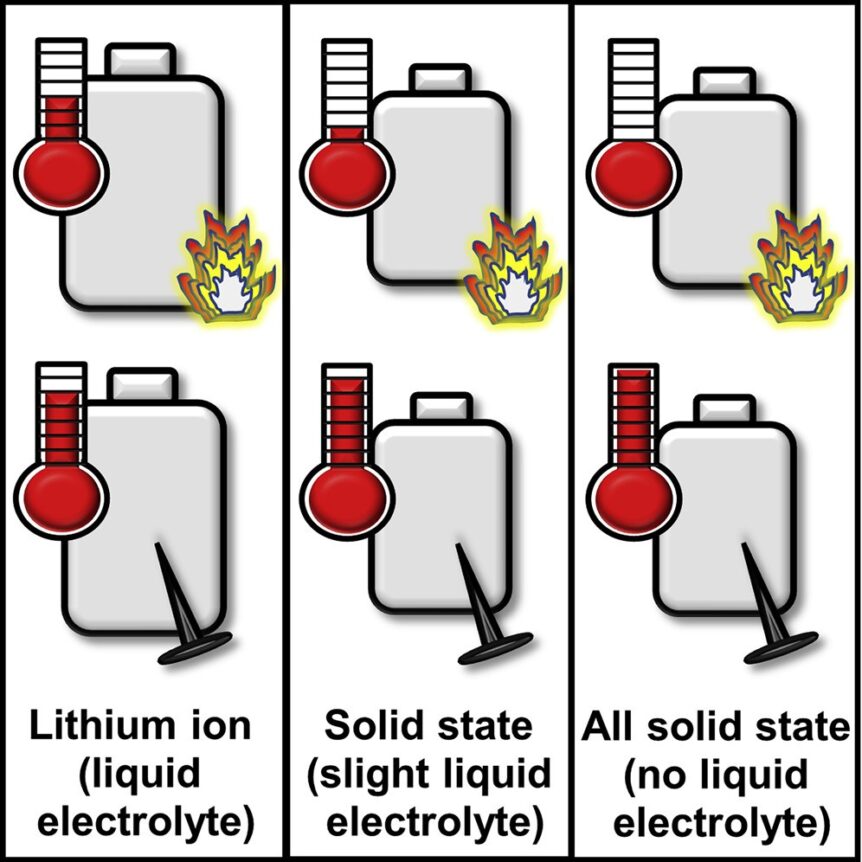What if our assumptions prove wrong? How willing are we to at least examine closely-held beliefs and accept a new, scientific finding? Sandia engineers are demonstrating that solid-state batteries containing a little liquid electrolyte can be safer than conventional lithium-ion cells. PV Buzz included a great executive summary in their article on the findings: A new study tackled a long-held assumption that adding some liquid electrolyte to improve performance would make solid-state batteries unsafe. Instead, the research team found that in many cases solid-state batteries with a little liquid electrolyte were safer than their lithium-ion counterparts. They also found, if the battery were to short-circuit, releasing all its stored energy, the theoretically super-safe, all-solid-state battery could put out a dangerous amount of heat. Those three points seem to contradict the conventional wisdom that eliminating electrolytes would lead to safer, less flammable batteries. Sandia engineers Alex Bates and John Hewson have published findings challenging that conventional wisdom in the peer-reviewed journal …
Don’t Smoke ‘Em Even if You’ve Got ‘Em
Biofuels would be wonderful if they didn’t starve people while feeding trucks, cars and airplanes. Living with such a constraint, though, might prove to be productive, profitable, and environmentally sound. The Guardian describes efforts in America’s tobacco country to grow a crop that will be less destructive of human lungs and hearts if it is consumed in jet engines rather than in cigarettes. “’We’re experimenting with varieties that were discarded 50 years ago by traditional tobacco growers because the flavors were poor or the plants didn’t have enough nicotine,’ explains Tyton [BioEnergy Systems] co-founder Peter Majeranowski.” In a case that oddly enough is GMO free, “Researchers are pioneering selective breeding techniques and genetic engineering to increase tobacco’s sugar and seed oil content to create a promising source of renewable fuel. The low-nicotine varieties require little maintenance, are inexpensive to grow and thrive where other crops would fail.” Fuel tobacco is a higher-value crop than hay, for instance, and “looser” farming …
Milking Magnesium for All It’s Worth
Magnesium carries two positive charges for every one which lithium carries. This simple fact was inspiration for Jordi Cabana, a University of Illinois at Chicago assistant professor of chemistry in developing a magnesium-based battery. Using magnesium in place of lithium led to this thought: “Because magnesium is an ion that carries two positive charges, every time we introduce a magnesium ion in the structure of the battery material we can move twice as many electrons,” He added, “We hope that this work will open a credible design path for a new class of high-voltage, high-energy batteries.” Cabana and his associates have shown they can replace the lithium ions, each of which carries a single positive charge, with magnesium ions, which have a plus-two charge, in battery-like chemical reactions, using an electrode with a structure like those in many of today’s devices. According to the University, the research is part of the Joint Center for Energy Storage Research, a Department of …
Lighter, More Powerful, Cheaper. Can J-CESR Bring Us Better Batteries?
$70,000 is a sizable base price for a car. That sum for the simplest of Tesla S sedans makes a bigger than average debt load for most of us, probably more than most can responsibly assume. Even the much anticipated model “E” at half that price is more stunning than the average sticker shock these days. What if, by some act of art or science, that $70,000 could be slashed to $14,000 for an electric vehicle that could travel 265 miles on a charge? That tall order is the order of the day for the Joint Center for Energy Storage Research, started two years ago under Dr. Steven Chu, who was then U. S. Secretary of Energy. He and his “teams” were charged with establishing the cooperative enterprise at “Argonne National Laboratory with a budget of $120 million over five years to create a battery five times more powerful and five times cheaper than today’s norms – all within five …
The New Mythbusters: Slow Charging May Not Make Batteries Last Longer
For the last 60 years, your editor remembers the oft-repeated advice from garage mechanics and now lithium-ion advocates that slow charging is the way to make your batteries last for many cycles. Where does this put Tesla, for instance, with its 20-minute Superchargers? Are you damaging your expensive cells by being in a hurry? In yet another example of counter-intuitive thinking at work, researchers at SLAC, the National Accelerator Laboratory at located on the Stanford University campus have challenged several tenets of conventional battery wisdom. According to PC World, their work, “published on Sunday in the Journal, Nature Materials, challenges the commonly held notion that slowly charging a battery helps prolong its life and that it’s damaging to a battery if a large amount of energy is withdrawn in a short time.” William Chueh, a senior author of the paper and researcher at the Stanford Institute for Materials and Energy Sciences (SIMES), told the magazine, “’We’ve always thought of a …
Flexibly Keeping Batteries from Blowing their Cool
Meltdown – not a term one wants to hear when confronting an obstinate boss or while levitating in his or her new Tom Swift Electric Octo-copter. But it is a real specter confronting electric vehicle users, and one amplified to positive levels of terror in flight. Two groups of researchers have come up with novel ways of quelling that terror and getting rid of the normally flammable electrolyte that helps make lithium battery fires truly memorable. If researchers at Chapel Hill and Washington State University are successful in their research, that acid electrolyte can be replaced with something safer and as a bonus in both cases, batteries using these new substances will perform better and longer. Researchers at the University of North Carolina at Chapel Hill, led by chemist Joseph DeSimone, Chancellor’s Eminent Professor of Chemistry in UNC’s College of Arts and Sciences and the William R. Kenan Jr. Distinguished Professor of Chemical Engineering at N.C. State University and of …
I’ll Take Manhattan
While much of battery research goes into crafting the ultimate anode, cathode or electrolyte, there seem to be few efforts, at least to outside observers, of integrated approaches to making a better total battery. That may change soon, with the Department of Energy announcing formation of a new Joint Center for Energy Storage Research (J-CESR, or J-Caesar). Dr. Steven Chu, U. S. Secretary of Energy, has established the Center at Argonne National Laboratory with a budget of $120 million over five years to create a battery five times more powerful and five times cheaper than today’s norms – all within five years. For those of us who’ve grown wary of those “breakthough” announcements that almost always include the line, “researchers say the new product could become a commercial reality in the next five to 20 years,” this may seem too hopeful. Secretary Chu’s announcement included several factors that may alleviate this wariness. The Department is putting up the money, …


